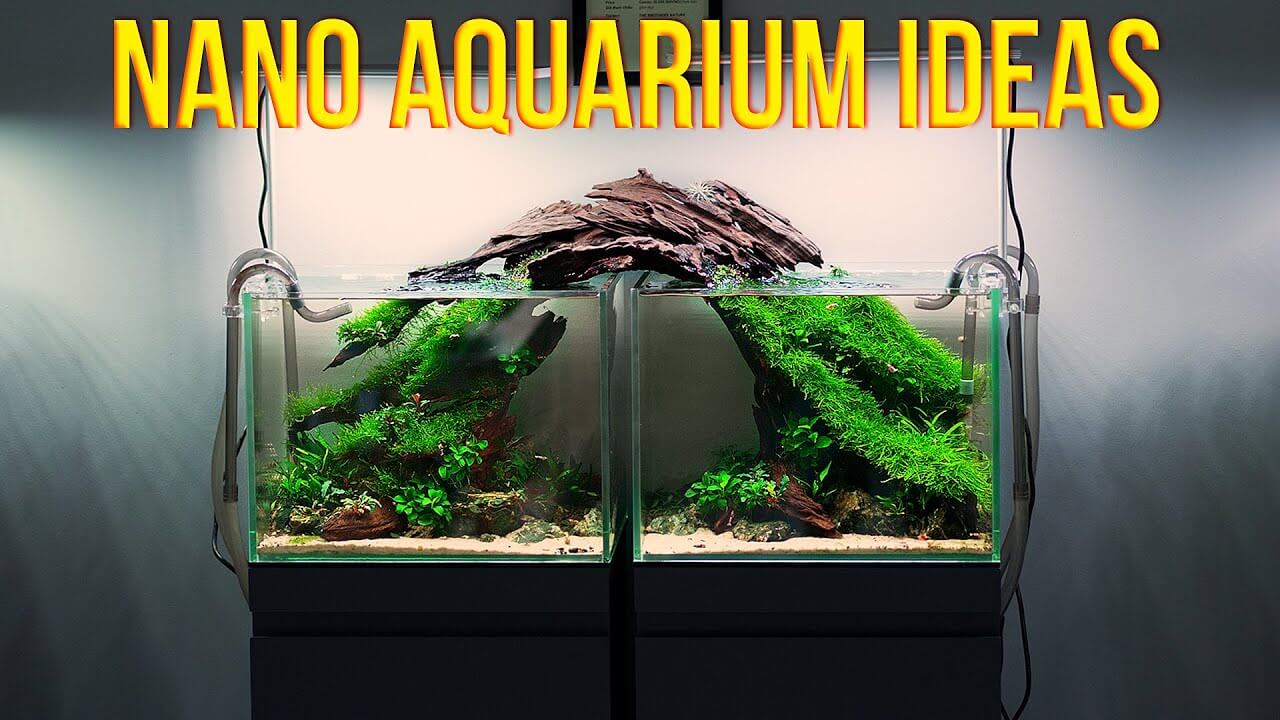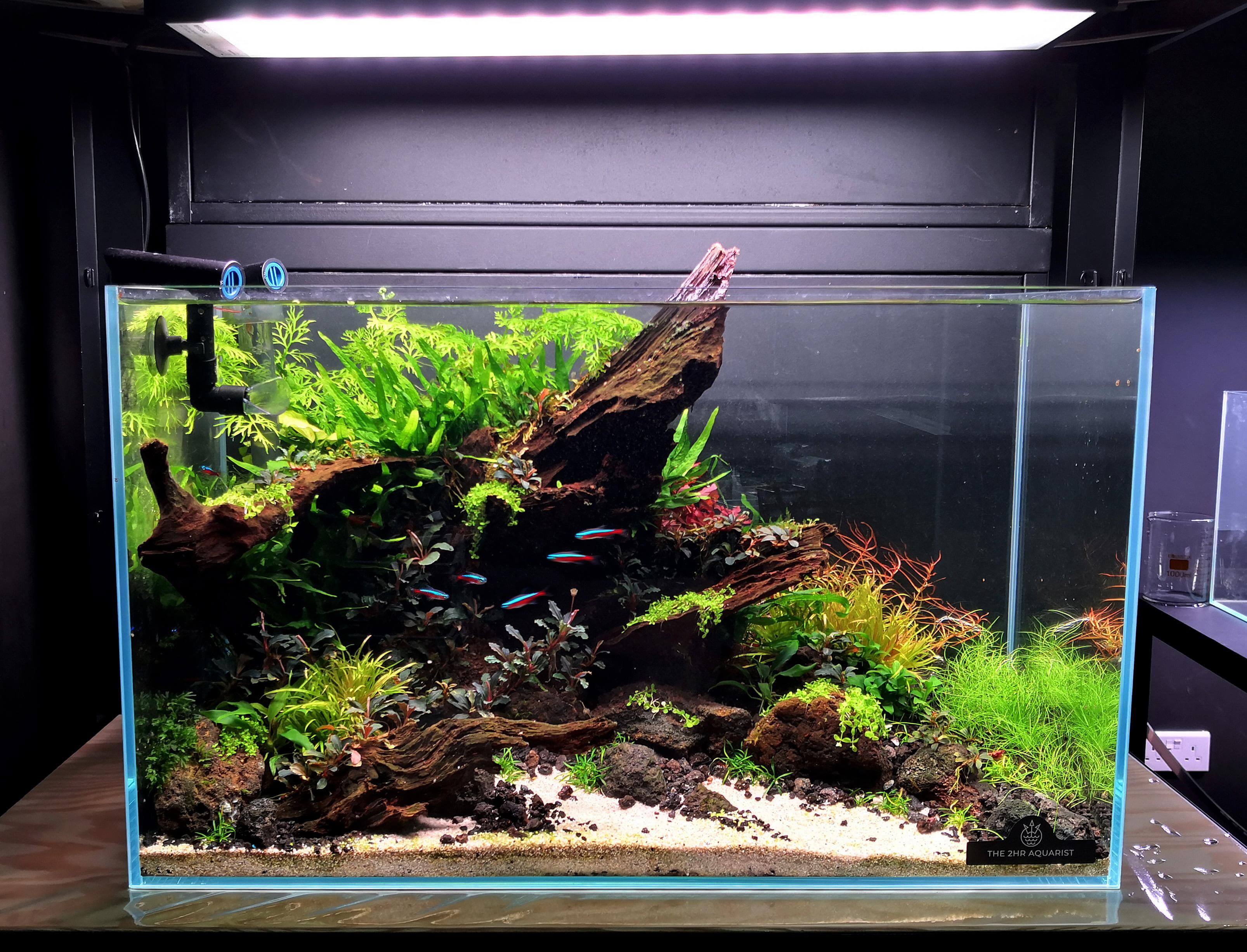Have you ever felt the urge to bring a slice of nature’s tranquillity into your home but felt restrained by the limited space? Imagine transforming even the tiniest corner into a lush, vibrant underwater oasis. Small tank aquascaping is not just about creating beauty in confined spaces; it’s a journey towards crafting your miniature aquatic world. Are you ready to discover how to make a significant impact with a small tank?
Key Takeaways:
- Small tank aquascaping allows you to create stunning underwater landscapes in limited spaces.
- Understanding the specific considerations for small tanks, such as water chemistry and lighting, is crucial for successful design.
- Design principles like focal points and simplicity help achieve visually appealing layouts in small tanks.
- Choosing the right plants and fish is essential for creating a balanced and thriving ecosystem in a small tank.
- Maintenance tips and troubleshooting techniques will help keep your small aquascape beautiful and healthy.
Why Small Tank Aquascaping?
Small tank aquascaping offers a unique opportunity to create captivating underwater landscapes in limited space. As an aquascaping design enthusiast, I have discovered the beauty and creativity that can be achieved when working with smaller tanks. In this section, I will discuss the dynamics of small tanks and the unique considerations that come with them, including water chemistry, lighting, and plant selection, as well as the importance of scale and proportion in creating visually appealing designs that maximize the available space.
Understanding Small Tank Dynamics
Designing a small tank aquascape requires a deep understanding of the dynamics specific to these compact aquariums. It’s essential to consider factors such as limited water volume, which can significantly impact water chemistry, filtration, and overall stability of the aquatic ecosystem. Additionally, the smaller footprint of a compact aquarium requires careful consideration of lighting to provide adequate illumination throughout the tank. Aquascapers can create a thriving and visually appealing environment by understanding these dynamics.
Unique Considerations for Small Tanks
When designing for small tanks, it’s crucial to consider specific aspects such as water chemistry, lighting, and plant selection. Maintaining stable water parameters becomes even more critical in a small tank, as fluctuations can have a more significant impact. Careful monitoring and adjustments are necessary to ensure optimal conditions for the plants and inhabitants. Lighting is another essential consideration, as it influences plant growth and the overall aesthetics of the aquascape. Choosing the right plants suitable for the tank size, lighting conditions, and growth patterns is crucial to creating a successful small tank aquascape.
The Importance of Scale and Proportion
One of the critical challenges in small tank aquascaping is working within limited space constraints. To create visually appealing designs, proper scale and proportion must be considered. Each element, such as rocks, driftwood, and plants, should be carefully selected and positioned to create a harmonious composition. By incorporating focal points and utilizing negative space, aquascapers can create the illusion of depth and scale, making the most of the available area. Paying attention to scale and proportion helps ensure a balanced and visually striking small aquascape.
Now that we have discussed the dynamics and unique considerations of small tank aquascaping, it’s time to explore the principles behind designing captivating layouts for these compact aquariums. The following section will delve into critical aquascaping design principles that can be applied effectively in small tank setups.
Design Principles for Small Tanks
When it comes to small tank aquascaping, understanding and incorporating design principles is essential for creating harmonious and visually striking underwater landscapes. In this section, we will outline key design principles that will elevate your small tank aquascape to the next level.
Focal Points
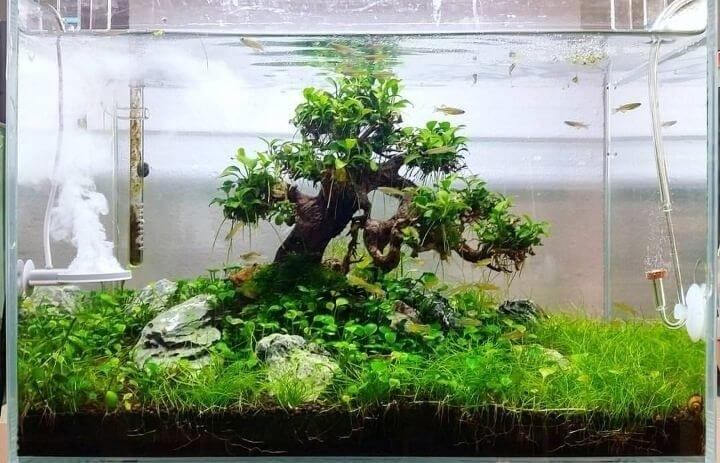
One crucial design principle in small tank aquascaping is using focal points. A focal point is a visually dominant element that captures the viewer’s attention and directs their gaze. It serves as the centrepiece or highlight of the aquascape. By strategically placing a focal point, such as a striking plant or a unique piece of driftwood, you can create a focal point that becomes the focal point of your design.
Depth Creation
Creating the illusion of depth is another key design principle in small tank aquascaping. By positioning taller plants or rocks in the background and gradually decreasing their size towards the front, you can create a sense of depth in your aquascape. This technique adds a visual element of perspective and makes the tank appear larger than it is.
Simplicity
Embracing simplicity is crucial in small tank designs. Limiting the number of plant species and hardscape elements can help create an uncluttered and visually appealing aquascape. By selecting a few carefully chosen plants and rocks, you can achieve a minimalist and elegant design that showcases the beauty of each element.
Tips for Effective Application
Here are some tips to effectively apply these design principles in small tank setups:
- Plan your design carefully before starting the aquascape. Consider the placement of focal points, the arrangement of plants and hardscape elements, and the overall balance of the tank.
- Experiment with different focal points to find the one best suits your aesthetic vision. Play with varying combinations of plant, driftwood arrangements, and rock layouts to create unique focal points.
- When creating depth, utilize different heights and textures of plants and hardscape elements. Place taller or larger items towards the back and gradually decrease their size towards the front.
- Keep your design simple and uncluttered. Avoid overcrowding the tank with too many plants or decorations, as this can detract from the overall aesthetic appeal.
- Regularly maintain and trim your plants to ensure they stay in their designated positions and don’t overwhelm the tank.
By understanding and applying these design principles and tips, you can achieve a stunning and well-balanced small tank aquascape that captivates and delights the viewer.
| Design Principles | Application Tips | |
|---|---|---|
| Focal Points | Avoid overcrowding the tank. Regularly maintain and trim plants. | |
| Depth Creation | Avoid overcrowding the tank. Regularly maintain and trim plants | |
| Simplicity | Avoid overcrowding the tank. Regularly maintain and trim plants. |
Essential Considerations
Regarding small tank aquascaping, several essential considerations must be considered. These considerations will ensure the success and sustainability of your aquascape. Let’s delve into each of these factors:
1. Tank Size
The size of your tank plays a significant role in determining the design possibilities for your aquascape. Small tanks offer a unique challenge and opportunity to create stunning underwater landscapes within limited space. Consider the size of your tank and choose a design that will best utilize the available area, creating a visually appealing layout.
2. Water Parameters
Maintaining optimal water parameters is crucial for the health and well-being of your aquatic plants and fish. Be sure to monitor and regulate parameters such as temperature, pH levels, and water hardness to create an environment supporting your chosen species’ growth and thriving. Research the specific requirements of your selected plants and fish to provide them with the ideal conditions.
3. Light Requirements
Lighting is a critical factor in the success of your aquascape. Different plant species have varying light requirements, ranging from low to high intensity. Understanding the specific light needs of your plants will help you choose the right lighting fixtures and ensure their healthy growth. Consider light duration and intensity to create an environment that promotes optimal plant photosynthesis.
Choosing the Right Plants and Fish
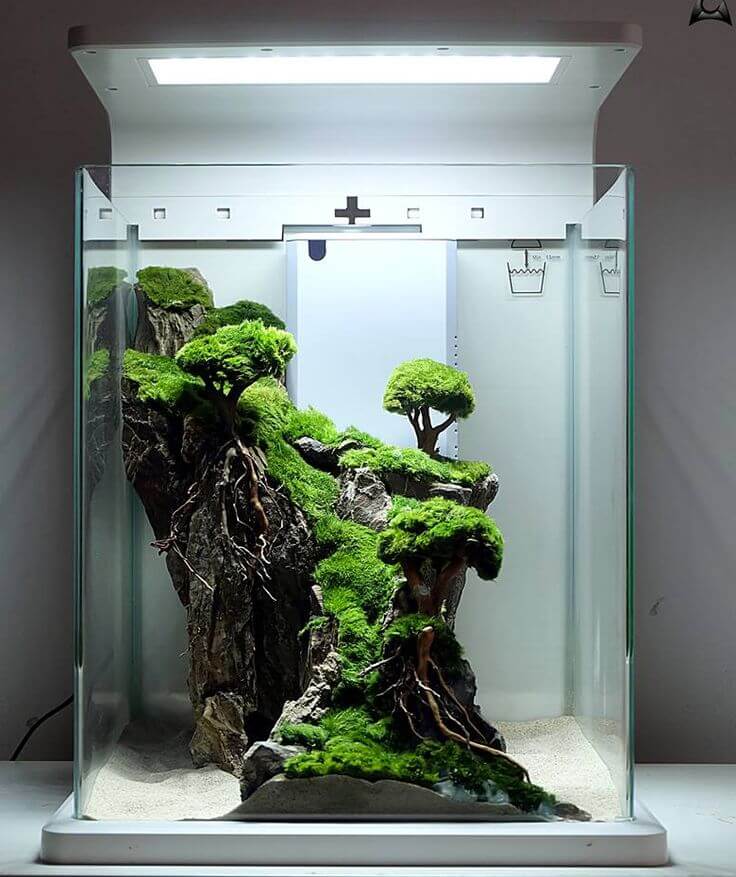
The choice of plants and fish is crucial in small tank aquascaping. To create a thriving and visually appealing ecosystem, it is important to select species that are well-suited to smaller environments. Here is a comprehensive guide to help you choose the perfect small tank plants and suitable fish species for your compact aquarium.
Guide on Selecting Species that Thrive in Smaller Environments
Regarding small tank aquascaping, selecting the right plants is essential for creating a lush and vibrant miniature aquatic garden. Consider the following factors when choosing small tank plants:
- Low-Light Options: Opt for plants that thrive in low-light conditions, as limited space often means less access to natural or artificial lighting.
- Compact Growth Requirements: Choose plants with compact growth habits that won’t outgrow the limited space available in your small tank.
Discussing Suitable Fish Species
Adding fish to your small tank can complement the visual appeal of your aquascape and create a harmonious ecosystem. Here are some factors to consider when selecting fish species:
- Size and Compatibility: Consider the adult size of the fish species and ensure they are compatible with the tank’s capacity to prevent overcrowding.
- Water Parameters: Research the specific water parameters preferred by the fish species and ensure they align with the conditions of your small tank.
- Behaviour: Choose fish species that exhibit peaceful behaviour and won’t disrupt the natural balance of your small tank ecosystem.
You can create a balanced and thriving ecosystem in your compact aquarium by carefully selecting small tank plants and suitable fish species.
Design Principles for Small Tanks
Layout Techniques, Focal Points, and Scaling
Building on the earlier design principles, explore specific layout techniques that work well in small tank aquascaping. Creating a visually appealing and harmonious aquascape within the constraints of a compact aquarium requires careful consideration of focal points, scaling elements, and overall balance.
One effective technique is to create focal points in your small tank aquascape. These areas in the aquarium draw the viewer’s attention and add visual interest. Focal points can be achieved by using bright or contrasting colours, unique rock formations, or eye-catching plant arrangements. By strategically placing these elements, you can create a captivating centrepiece that becomes the highlight of your aquascape.
Scaling is another crucial aspect to consider when designing small tanks. It involves choosing and arranging elements proportionately to the tank size and creating a sense of depth and perspective. In a compact aquarium, it’s crucial to carefully select plants, rocks, and other hardscape materials that are appropriate in size and won’t overpower the tank. Scaling elements correctly will help create a visually balanced and natural-looking aquascape.
In addition to focal points and scaling, maintaining overall balance is essential for a successful small tank aquascape. Balancing the distribution of plants, rocks, and open spaces throughout the aquarium helps create a visually pleasing arrangement. It’s important to avoid overcrowding and maintain a sense of openness, even in a limited space. You can achieve a well-balanced and visually striking aquascape by carefully arranging the elements and considering negative space.
Innovative Small Tank Ideas
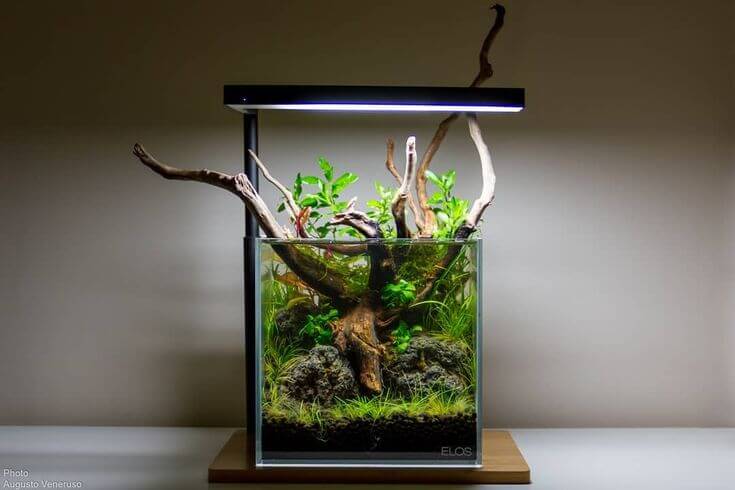
To continue fueling your creativity in small tank aquascaping, I’m excited to introduce you to some innovative techniques that will elevate your design game. These techniques will allow you to create unique and visually stunning aquascapes in your small tanks.
Creative Aquascaping Techniques
One technique that adds a dramatic vertical dimension to your aquascape is vertical gardening. You can create lush green walls that reach upward by attaching plants to structures such as trellises or mesh walls. This adds depth to your small tank and provides a striking visual impact.
Another technique that can breathe life into your aquascape is the strategic use of stones and driftwood. By carefully placing these natural elements, you can create intricate and natural-looking landscapes that mimic the beauty of nature. Experiment with different shapes, sizes, and textures to achieve a visually captivating result.
For a whimsical touch, consider creating miniaturized landscapes within your small tank. This technique allows you to design and build tiny scenes inspired by real-world landscapes or fantasy worlds. You can use miniature figurines, plants, and rocks to bring your miniature landscape to life.
Step-by-Step Instructions and Tips
To help you implement these innovative aquascaping techniques, here are some step-by-step instructions and tips:
- Vertical Gardening:
- Select hardy aquatic plants suitable for vertical growth.
- Create a structure or attach a mesh wall to the back of your tank.
- Secure the plants to the structure using plant ties or fishing lines.
- Regularly trim and maintain the vertical garden to ensure healthy growth.
- Using Stones and Driftwood:
- Choose stones and driftwood pieces that complement each other and the overall theme of your aquascape.
- Position the stones and driftwood strategically, considering scale, balance, and natural flow.
- Anchor the stones and driftwood in the substrate using aquarium-safe adhesive or by burying them securely.
- Arrange plants around the stones and driftwood to create a harmonious and natural-looking composition.
- Creating Miniaturized Landscapes:
- Plan the design and layout of your miniature landscape, considering the available space and desired theme.
- Use small-scale figurines, plants, and rocks to create the desired scene.
- Consider using a separate piece of driftwood or a small rock as a focal point for your miniature landscape.
- Regularly trim and maintain the plants to ensure they stay in scale with the overall design.
Examples of Creatively Designed Small Aquascapes
Now, let’s take a moment to appreciate the beauty and artistry of creatively designed small aquascapes. Below is an example that showcases the implementation of the techniques discussed:
This aquascape demonstrates an incredible use of vertical gardening, with plants climbing up the structure to create a stunning visual impact. The careful arrangement of stones and driftwood adds a natural and balanced element to the composition. This small tank design exemplifies the innovative aquascaping techniques and the unique concepts that can be realized in compact aquariums.
Maintenance Tips for Small Aquascapes
Maintaining the beauty and health of small aquascapes requires regular upkeep. To ensure the longevity of your miniature underwater garden, here are some essential maintenance tips to follow:
Water Change Tips
Regular water changes are vital for maintaining optimal water quality in your compact aquarium. It helps remove accumulated toxins and replenishes essential nutrients for healthy plant growth. Follow these tips:
- Perform partial water changes of about 15-20% weekly to maintain water quality.
- Use a siphon or gravel vacuum to remove debris from the substrate.
- Treat tap water with a suitable water conditioner to remove chlorine and chloramine.
Plant Care
Proper plant care ensures vibrant and lush vegetation in your small aquascape. Follow these guidelines:
- Trim and prune your plants regularly to maintain their desired shape and prevent overcrowding.
- Monitor nutrient levels and supplement with liquid or substrate fertilizers as necessary.
- Remove dead or decaying plant material promptly to prevent water contamination and algae growth.
Controlling Algae Growth
Algae can be a common issue in small aquascapes. To keep it under control, implement the following practices:
- Ensure proper lighting duration and intensity, as excessive light can promote algae growth.
- Consider using algae-eating fish or invertebrates, such as nerite snails or Siamese algae eaters, to help control algae naturally.
- Perform regular maintenance tasks, such as manually cleaning the glass and removing any visible algae.
Following these maintenance tips can keep your small aquascape thriving and visually appealing for a long time.
Common Challenges and Solutions
Despite careful planning, small aquascapes can sometimes face challenges. In this section, I will address common issues such as algae outbreaks, water quality problems, and plant growth difficulties that aquascapers may encounter when creating small tank aquascapes. I will also provide practical solutions and troubleshooting techniques to help overcome these challenges and maintain the beauty and health of your compact aquarium.
Algae Outbreaks
Algae outbreaks are a common problem in small aquascapes. They can quickly overtake the tank, affecting the ecosystem’s aesthetic appeal and overall health. To combat algae outbreaks, consider the following solutions:
- Ensure proper lighting: Optimize the lighting conditions in your tank by controlling the intensity and duration. Use a timer to maintain a consistent lighting schedule and avoid excessive exposure to light.
- Balance nutrients: Excess nutrients, particularly nitrogen and phosphorous, can fuel algae growth. Regularly test the water parameters and adjust the feeding and fertilization routine to prevent nutrient imbalances.
- Introduce algae-eating species: Adding algae-eating fish or invertebrates, such as Otocinclus catfish or Amano shrimp, can help control algae growth by consuming it.
- Perform regular maintenance: Regularly clean the tank, remove any dead or decaying plant matter, and perform water changes to keep the nutrient levels in check.
Water Quality Issues
Maintaining optimal water quality is essential for the health of your small aquascape. Here are some common water quality issues and their solutions:
- High ammonia or nitrite levels: Ammonia and nitrites are toxic to fish and can inhibit plant growth. Ensure proper tank cycling before adding livestock and regularly monitor ammonia and nitrite levels. Perform water changes and use a biological filter to establish a healthy nitrogen cycle.
- Low oxygen levels: Inadequate oxygen can stress fish and hinder plant growth. Improve oxygenation by adding airstones or increasing surface agitation. Avoid overcrowding the tank and ensure proper water circulation.
- Poor water clarity: Cloudy or murky water can harm the aesthetics of your aquascape. Ensure proper filtration and consider using activated carbon or a water clarifier to remove impurities and improve water clarity.
Plant Growth Problems
Healthy plant growth is vital for the success of any aquascape. If you’re encountering issues with plant growth in your small tank, try the following troubleshooting techniques:
- Provide adequate lighting: Different plants have varying lighting requirements. Ensure your plants are receiving the required amount and quality of light. Consider using a full-spectrum aquarium light or supplementing with additional lighting if needed.
- Optimize nutrient levels: Monitor and adjust nutrient levels by using fertilizers specifically formulated for aquatic plants. Strike a balance between providing enough nutrients without creating an excess that can fuel algae growth.
- Ensure proper CO2 levels: Carbon dioxide (CO2) is crucial for optimal plant growth. If you have demanding plant species, consider adding a CO2 injection system or using liquid carbon supplements to enhance plant growth.
- Prune and trim regularly: Regularly trim your plants to remove dead or dying leaves and encourage healthy new growth. Pruning helps maintain the desired shape and prevents overcrowding.
| Problem | Solution |
|---|---|
| Algae Outbreaks | Optimize lighting, balance nutrients, introduce algae-eating species, and perform regular maintenance. |
| Water Quality Issues | Monitor ammonia and nitrite levels, improve oxygenation, and use appropriate filtration methods. |
| Plant Growth Problems | Provide adequate lighting, optimize nutrient levels, ensure proper CO2 levels, and regularly prune and trim plants. |
Resources and Inspiration
For aquascapers looking to expand their knowledge and find inspiration, I recommend exploring the following resources:
- Aquascaping World: A comprehensive online community dedicated to aquascaping where you can connect with like-minded enthusiasts, share ideas, and seek advice.
- Aquascape Addiction: This website offers a wealth of information on aquascaping, including tutorials, step-by-step guides, and product recommendations.
- Aquarium Co-Op: A popular YouTube channel hosted by Cory McElroy, providing educational videos on aquarium care, aquascaping techniques, and plant selection.
- Amazon: Browse through a wide selection of books on aquascaping and aquarium design, such as “The Art of Aquascaping” by James Findley and “Nature Aquarium World: How You Can Make A Most Beautiful Aquarium” by Takashi Amano.
These resources will offer valuable information, tips, and a wealth of inspiration for designing and maintaining small tank aquascapes.
Conclusion
In conclusion, small tank aquascaping presents a unique opportunity to create captivating underwater landscapes in limited spaces. The art of small tank aquascaping allows enthusiasts to transform tiny aquariums into stunning miniature aquatic gardens. With proper knowledge, creativity, and care, anyone can achieve beautiful, thriving small tank aquascapes.
Embarking on a small tank aquascaping journey is an exciting and rewarding experience. It allows you to showcase your creativity and create a peaceful and visually appealing environment in your home. By carefully selecting the appropriate plants and fish, applying design principles, and maintaining optimal conditions, you can bring the beauty of nature into even the smallest of spaces.
Whether you are a beginner or a seasoned aquascaper, the possibilities with small tank aquascaping are endless. Start your compact aquarium project today and witness the wonders that can be achieved within the confines of a small tank. Don’t hesitate to experiment, learn from others, and explore the resources available to enhance your skills and expand your creativity.
FAQ
What is aquascaping?
Aquascaping is the art of designing and arranging aquatic plants, rocks, and driftwood to create visually stunning underwater landscapes in aquariums.
What is small tank aquascaping?
Small tank aquascaping is the practice of designing and arranging aquatic plants, rocks, and driftwood in compact aquariums to create visually appealing miniature aquatic gardens.
Why is small tank aquascaping important?
Small tank aquascaping allows aquascapers to maximize the beauty of their aquariums even in limited spaces, creating captivating underwater landscapes.
What are the considerations for small tanks?
Small tank aquascaping requires specific considerations such as water chemistry, lighting, plant selection, scale, and proportion to achieve visually appealing designs.
What are the key design principles for small tank aquascaping?
Key design principles for small tank aquascaping include creating focal points, creating the illusion of depth, and embracing simplicity in the layout.
What should I consider when choosing plants and fish for small tank aquascaping?
When choosing plants and fish for small tank aquascaping, consider selecting species that thrive in smaller environments and can coexist harmoniously.
What are some innovative techniques for small tank aquascaping?
Innovative techniques for small tank aquascaping include vertical gardening, using stones and driftwood, and creating miniaturized landscapes for a whimsical touch.
How do I maintain the beauty and health of small aquascapes?
Maintaining small aquascapes requires regular upkeep such as water changes, plant care, and controlling algae growth.
What are some common challenges in small tank aquascaping, and how can I overcome them?
Common challenges in small tank aquascaping include algae outbreaks, water quality issues, and plant growth problems. They can be overcome through proper maintenance and troubleshooting techniques.
Where can I find resources and inspiration for small tank aquascaping?
You can find resources such as books, websites, and online communities dedicated to aquascaping for further learning and inspiration.

